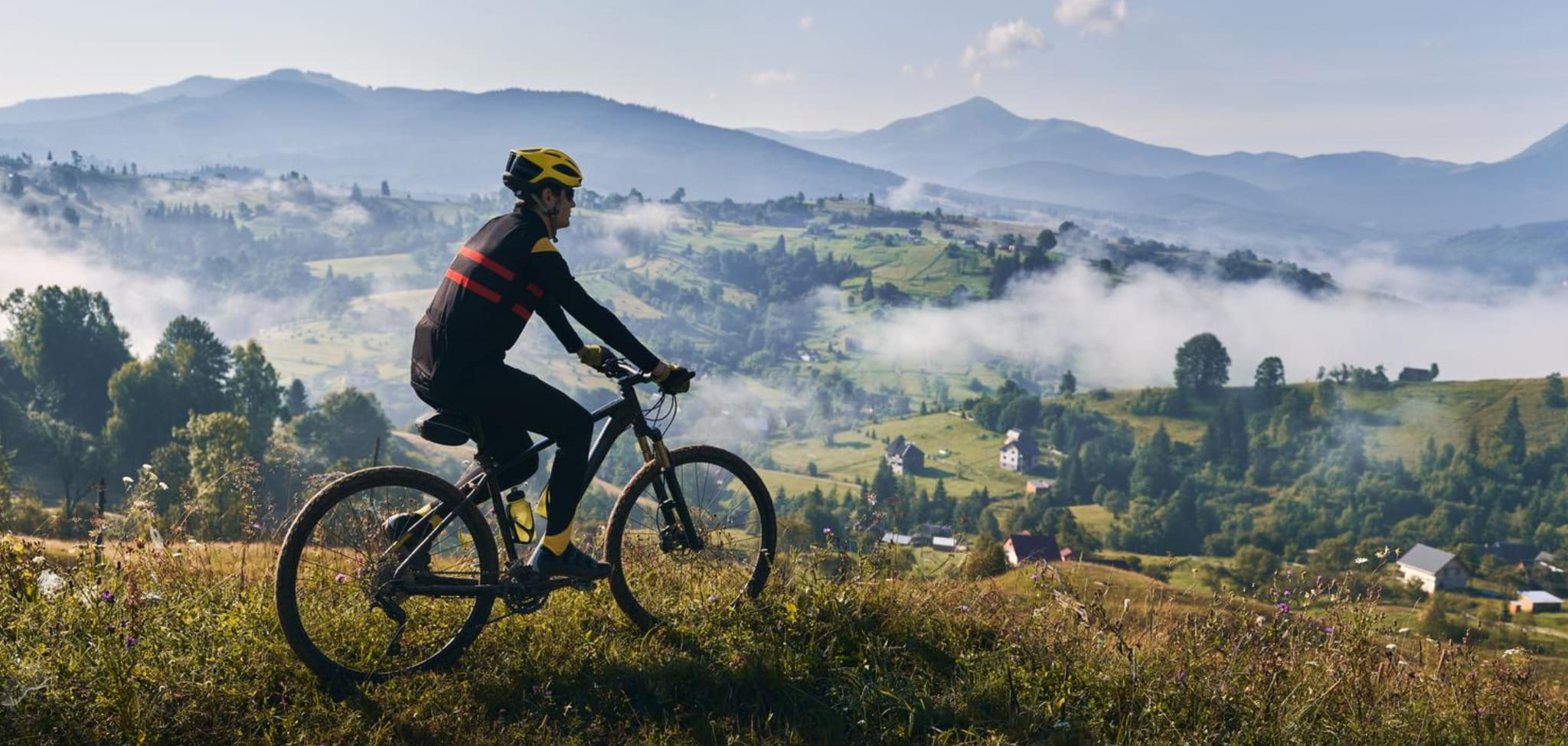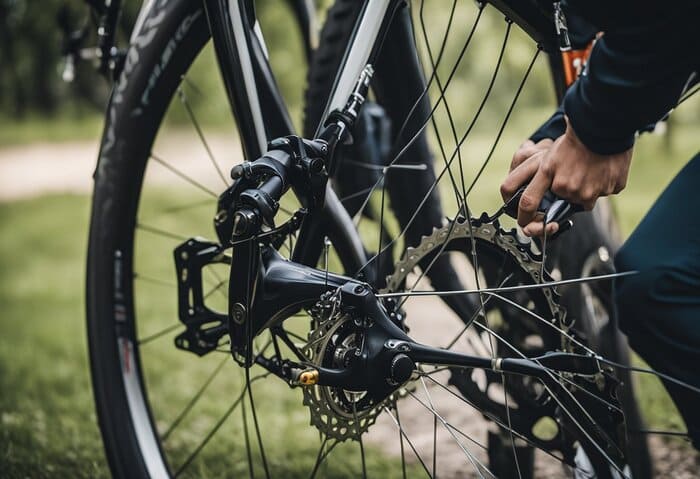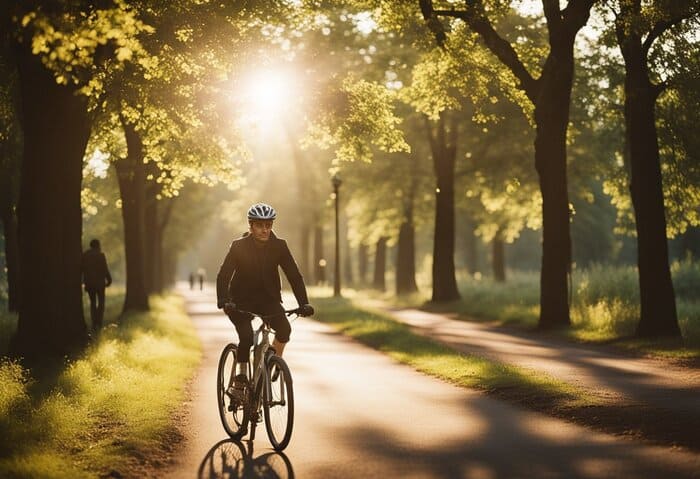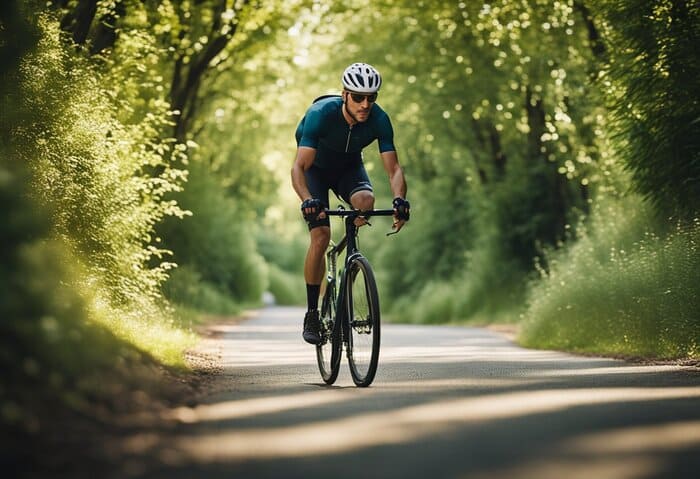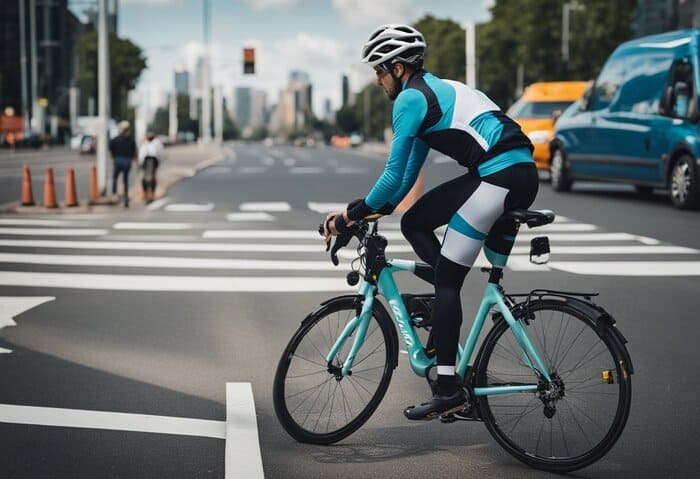Cycling for Beginners: A Comprehensive Guide to Getting Started
Cycling is a fantastic activity that offers numerous health benefits and a sense of adventure. Whether you’re looking to get fit, save money on transportation, or simply enjoy the great outdoors, cycling is a great choice. If you’re new to cycling and unsure where to start, this comprehensive guide will provide you with all the information you need to get on your bike and start pedaling. From choosing the right bike to essential accessories and training plans, we’ve got you covered.
Why Start Cycling?
Cycling offers numerous benefits that make it an attractive activity for people of all ages and fitness levels. Here are just a few reasons why you should consider hopping on a bike:
- Exercise and Fitness: Cycling is a fantastic way to get in shape and improve your overall fitness. It provides a low-impact cardiovascular workout that helps strengthen your heart, lungs, and muscles.
- Eco-Friendly Transportation: By choosing to cycle instead of driving a car, you’re reducing your carbon footprint and contributing to a greener environment.
- Cost Savings: Cycling is a cost-effective mode of transportation. Unlike cars, bikes don’t require fuel, parking fees, or expensive maintenance.
- Stress Relief: Cycling allows you to escape the hustle and bustle of daily life and enjoy the tranquility of the outdoors. It’s a great way to clear your mind and reduce stress.
- Exploration and Adventure: Cycling enables you to discover new places and experience your surroundings at a slower, more intimate pace.
Now that you understand the benefits of cycling, let’s address some common concerns and myths that may be holding you back from getting on a bike.
Understanding Cycling Basics
Before starting, beginners should understand the basics of cycling to ensure a safe and enjoyable experience.
Bike Fit
One of the most important aspects of cycling is bike fit. A properly fitted bike can help prevent injury and improve performance. Beginners should ensure that their bike is the right size for their body and that the saddle height is adjusted correctly. They should also make sure that the handlebars are at a comfortable height and distance from the saddle.
Shifting Gears
Shifting gears is an essential skill for any cyclist. It allows riders to maintain a comfortable cadence and tackle hills and headwinds. Beginners should practice shifting gears on flat terrain before attempting more challenging rides. They should also understand the different gear combinations and when to use them.
Braking
Proper braking is crucial for safety and control. Beginners should understand how to use both the front and rear brakes and when to apply them. They should also practice braking on different surfaces and in different weather conditions.
Riding Technique
Riding technique is an important aspect of cycling. Beginners should focus on maintaining a relaxed grip on the handlebars and keeping their upper body still. They should also pedal in a smooth, fluid motion and avoid bouncing in the saddle. Finally, they should always be aware of their surroundings and follow traffic laws.
Choosing the Right Bike
Cycling is a great way to stay fit and enjoy the outdoors. However, for beginners, choosing the right bike can be a daunting task. In this section, we will discuss the different types of bikes and what to consider when selecting the right one for you.
Types of Bikes
There are several types of bikes to choose from, each with its own unique features and benefits. The most common types of bikes include road bikes, mountain bikes, hybrid bikes, and cruiser bikes.
- Road Bikes: Designed for speed and efficiency on smooth roads, road bikes are lightweight and have narrow tires. They are perfect for long-distance rides and racing.
- Mountain Bikes: Designed for off-road terrain, mountain bikes have wider tires and suspension for shock absorption. They are great for trail riding and can handle rough terrain.
- Hybrid Bikes: A combination of road and mountain bikes, hybrid bikes are versatile and can handle a variety of terrains. They have wider tires and a more upright riding position than road bikes.
- Cruiser Bikes: Designed for comfort and style, cruiser bikes have wide tires, a relaxed riding position, and are perfect for casual rides around town.
Size and Fit
Choosing the right size and fit is essential for a comfortable and safe ride. When selecting a bike, consider the following:
- Frame Size: The frame size should be appropriate for your height and inseam. A bike that is too big or too small can cause discomfort and affect your performance.
- Saddle Height: The saddle height should be adjusted so that your leg is almost fully extended when the pedal is at the bottom of the stroke.
- Handlebar Height: The handlebar height should be adjusted for a comfortable riding position. A too low or too high handlebar can cause discomfort and affect your control of the bike.
In summary, choosing the right bike is crucial for a comfortable and enjoyable ride. Consider the type of bike that best suits your needs and select the appropriate size and fit for your body. With the right bike, you can start your cycling journey with confidence.
Essential Gear and Accessories
Now that you’re ready to hit the road, let’s discuss the essential gear and accessories you’ll need for a safe and enjoyable cycling experience.
Protective Gear
- Helmet: A properly fitting helmet is a must-have for cycling. Choose a helmet that meets safety standards and provides adequate protection for your head.
- Eyewear: Invest in a pair of cycling-specific sunglasses or protective eyewear to shield your eyes from debris, glare, and insects.
Repair Equipment and Tools
It’s essential to carry basic repair equipment and tools with you to handle any unexpected issues during your rides. Here’s a list of essential items:
- Spare tubes: Carry one or two extra inner tubes to quickly replace a punctured tube on the go.
- Tire levers: These tools are essential for removing and installing tires when fixing a flat.
- Portable pump: A compact and lightweight pump will allow you to inflate your tires when needed.
- Multi-tool: Invest in a quality multi-tool that includes various sizes of Allen keys, screwdrivers, and other essential bike tools.
Visibility and Safety Equipment
To ensure your visibility and safety on the road, consider the following items:
- Lights: Attach a white front light and a red rear light to your bike to make yourself visible to others, especially when riding in low-light conditions or at night.
- Reflective clothing: Wear high-visibility clothing or accessories that have reflective elements to enhance your visibility to motorists.
Cycling Apparel
While not essential for beginners, cycling-specific apparel can greatly enhance your comfort and performance. Consider the following items:
- Cycling shorts: Padded cycling shorts provide extra cushioning and reduce saddle soreness during longer rides.
- Jerseys: Cycling jerseys are designed to wick away sweat and provide ventilation, keeping you comfortable during rides.
- Cycling shoes: If you’re using clipless pedals, invest in cycling shoes that allow you to efficiently transfer power to the pedals.
Additional Accessories
While not essential, these accessories can enhance your cycling experience:
- Water bottle and cage: Stay hydrated during your rides by attaching a water bottle cage to your bike frame and carrying a water bottle.
- Bike computer or smartphone app: Track your distance, speed, and other metrics using a bike computer or a smartphone app like Strava.
Remember to tailor your gear and accessories to your specific cycling needs and preferences.
Maintenance and Care
just like any other mode of transportation, bicycles require regular maintenance and care to keep them in good working condition. In this section, we will cover some essential bike maintenance tips for beginners.
Cleaning Your Bike
Keeping your bike clean is an essential part of bike maintenance. Dirt, grime, and debris can build up on your bike, causing it to function poorly. To clean your bike, you will need a few basic tools, including a bucket of warm soapy water, a sponge, a brush, and a towel.
First, rinse your bike with a hose to remove any loose dirt or debris. Next, use the sponge and warm soapy water to clean the frame, wheels, and other parts of your bike. Use the brush to scrub any hard-to-reach areas, such as the chain and gears. Rinse your bike thoroughly with clean water and dry it off with a towel.
Basic Repairs
Even with regular maintenance, your bike may still require some basic repairs from time to time. Some common bike repairs include fixing a flat tire, adjusting the brakes, and tightening loose bolts.
If you get a flat tire, you will need to remove the wheel from your bike and replace the inner tube. To adjust the brakes, you will need to loosen or tighten the brake cable using a wrench. Tightening loose bolts can be done using a set of Allen wrenches.
It’s important to note that more complex repairs, such as replacing the chain or cassette, should be done by a professional bike mechanic. Attempting these repairs on your own could cause further damage to your bike and potentially lead to injury.
By following these basic maintenance and care tips, beginners can keep their bikes in good working condition and ensure a safe and enjoyable cycling experience.
Dispelling Common Cycling Myths
Several misconceptions about cycling often discourage people from giving it a try. Let’s debunk some of these myths and set the record straight:
1: Biking requires too much gear.
Reality: The basic necessities for cycling are just you, a bike, and a helmet. While additional gear can enhance your experience, it’s not essential to get started. Focus on the essentials and gradually add gear as needed.
2: It’s costly to buy a bike and cycling gear.
Reality: While cycling gear can be expensive, it’s still more affordable than owning and maintaining a car. Bicycles require minimal maintenance, and you can find budget-friendly options that suit your needs.
3: Only expensive bikes are any good.
Reality: While high-end bikes offer advanced features and technologies, any bike in good working condition can serve you well. Don’t let the price tag discourage you from getting started.
4: Biking takes too much time.
Reality: While cycling may require some extra planning and time compared to driving, it can actually be faster than driving in certain situations, particularly during rush hour traffic. Additionally, you can multitask and run errands while cycling.
5: Bicycling is too dangerous.
Reality: While there are risks associated with cycling, most cyclists ride for many years without incident. By following traffic rules, wearing bright clothing, and being aware of your surroundings, you can greatly reduce the chances of accidents.
6: Bike seats are uncomfortable.
Reality: Bike seats come in a variety of styles and designs. If your current saddle is uncomfortable, try upgrading to one with gel padding or one that is specifically designed for your gender. Finding the right saddle for your body can greatly enhance your comfort.
7: I’m clueless about how to maintain my bike.
Reality: Learning the basics of bike maintenance is easier than you think. There are plenty of resources available, including online tutorials and classes offered by local bike shops. If you prefer, you can always take your bike to a professional for tune-ups and repairs.
8: I’m too out of shape to ride.
Reality: Cycling is a great way to improve your fitness level, regardless of your starting point. Start at your own pace and gradually increase your endurance and strength over time. Consult with a doctor if you have any health concerns before starting a cycling routine.
9: You can’t carry much stuff on a bike.
Reality: Bikes are more versatile than you might think. From wearing a daypack or messenger bag to attaching panniers or using a bike trailer, there are various ways to transport your belongings while cycling.
10: It’s too far for me to commute to work.
Reality: You don’t have to commute the entire distance on your bike. Consider riding part of the way and using public transportation or carpooling for the rest. Gradually increase your cycling distance as you build your fitness.
11: I’ll get sweaty.
Reality: Sweating is a natural part of physical activity, but you can manage it by riding at a more leisurely pace or choosing cooler times of the day to cycle. Remember, sweating is a sign that you’re getting a good workout!
12: My work clothes will get wrinkled.
Reality: If you’re concerned about wrinkling your work clothes, you can either pack them in a way that minimizes wrinkles or bring a change of clothes with you. Consider using packing folders or cubes to keep your garments neat.
Preparing for Your Cycling Journey
Before hopping on your bike, it’s essential to ensure that it’s in good working condition and that you have the necessary safety measures in place. Here are some key considerations:
Bike Maintenance: Getting Your Bike Ready
A well-maintained bike will provide a smoother and safer riding experience. If your bike hasn’t been used in a while or you notice any specific issues, it’s a good idea to take it to a professional for a tune-up. However, if you prefer to do it yourself, there are resources available to help you learn the basics of bike maintenance.
Pre-ride Inspection
Before embarking on a ride, it’s crucial to conduct a pre-ride inspection to ensure that your bike is safe and ready to go. Here’s a checklist to follow:
- Size: Make sure the bike is the right size for you, with sufficient clearance between your body and the top tube.
- Seat height: Adjust the seat height to a comfortable position and ensure that it’s level.
- Wheels: Check that the quick-release levers or bolts are fully secured, and spin the wheels to ensure they rotate smoothly without wobbling.
- Brakes: Squeeze the brake levers to check if the brake pads make proper contact with the rims or rotors.
- Tires: Inspect the tires for cracks, excessive wear, and proper inflation.
- Frame and headset: Check the frame for any cracks or damage, and ensure that the headset is properly adjusted.
- Gears: Shift through the gears to ensure smooth operation and proper chain movement.
- Cranks: Test the cranks by giving them a pull to ensure they’re tight and secure.
- Chain: Check the chain for proper lubrication and smooth movement.
By following these steps, you can ensure that your bike is in good working order and ready for your cycling adventures.
Fit Your Helmet
Wearing a helmet is an essential safety measure when cycling. It can significantly reduce the risk of head injuries in the event of a fall or collision. Here’s how to properly fit your helmet:
- Adjust the fit dial or cinching mechanism: Make sure the helmet fits snugly but comfortably on your head.
- Position: The helmet should sit level on your head, just above your eyebrows. It should cover the top of your forehead without obstructing your vision.
- Strap placement: The strap should form a “Y” shape just below your earlobes, with no more than one or two fingers’ width of space between the chin and the strap.
- Final checks: Shake your head to ensure that the helmet stays in place and doesn’t move. You should be able to open your mouth wide without the chinstrap pulling the helmet down.
Remember to choose a helmet that meets safety standards and has the appropriate certifications.
Finding the Right Route: Pick a Safe Route
Choosing the right route for your cycling adventures is crucial for a safe and enjoyable experience. Consider the following factors when planning your routes:
- Road Conditions: Look for routes with well-maintained roads and bike lanes, if available. Avoid roads with heavy traffic or poor road conditions.
- Safety: Consider the overall safety of the route, Prioritize routes that minimize potential hazards, such as busy intersections or areas with high crime rates.
- Scenic Routes: Take advantage of bike paths, parks, or scenic roads that allow you to enjoy beautiful surroundings while cycling.
- Elevation: Depending on your fitness level and goals, choose routes with appropriate elevation profiles. Gradually challenge yourself with hillier routes as you become more experienced.
- Local Resources: Reach out to local biking clubs, bike shops, or online communities to gather insights and recommendations on popular cycling routes in your area.
Taking a Practice Spin
If you’re new to cycling or haven’t been on a bike in a while, it’s a good idea to take a few practice spins to get comfortable with your bike and build confidence. Here are some tips for your practice sessions:
- Start Slow: Begin with short, easy rides to get comfortable on your bike. Gradually increase the duration and intensity of your rides as your fitness improves.
- Practice Bike Handling: Spend time getting familiar with the basic skills of cycling, such as braking, steering, and shifting gears. Find an empty parking lot or a quiet street to practice these skills.
- Ride with Confidence: Follow traffic rules, be predictable, and communicate your intentions to other road users. Ride defensively and always be aware of your surroundings.
These practice sessions will help you develop basic cycling skills and get accustomed to your bike’s handling and controls. Remember, cycling is a journey, and it’s okay to start at your own pace. Focus on building your skills and gradually increasing your endurance.
Cycling Tips for Beginners
To make your cycling experience enjoyable and safe, keep these tips in mind:
- Maintain proper tire pressure: Keep your tires properly inflated to make your ride smoother and reduce the risk of punctures.
- Protect your eyes: Wear eyewear to protect your eyes from debris, insects, and harsh sunlight.
- Use mudguards: Invest in mudguards to keep yourself and your bike clean, especially when cycling in wet conditions.
- Stay fueled and hydrated: Carry snacks and water to keep yourself energized and hydrated during longer rides.
- Position yourself correctly: Find a riding position that is comfortable and allows you to maintain proper posture and control.
- Learn group riding skills: If cycling in a group, learn how to ride in a group formation and communicate effectively with other cyclists.
- Take corners safely: Apply downward pressure on the outside pedal when taking corners to improve grip and stability.
Riding in Traffic: Safety Tips
Cycling in traffic can be intimidating, but following some safety guidelines can help ensure a safer riding experience. Here are some tips for riding in traffic:
- Follow the Rules: Obey traffic laws and signals, just like you would when driving a car.
- Be Visible: Wear bright, reflective clothing and use lights when riding in low-light conditions. Make eye contact with drivers to ensure they see you.
- Claim Your Space: Ride in a straight line and avoid swerving in and out of traffic. Be predictable and assertive when taking your lane if necessary.
- Use Hand Signals: Indicate your intentions by using proper hand signals for turning or stopping. This helps drivers anticipate your movements.
- Stay Alert: Continuously scan your surroundings, check blind spots, and be aware of potential hazards such as opening car doors or pedestrians crossing.
Remember, your safety should always be your top priority when riding in traffic. If you feel uncomfortable, dismount and walk your bike until you find a safer route.
Riding Hazards: Navigating Potential Dangers
While cycling, you may encounter certain hazards that require extra caution. Here are some common hazards and how to navigate them:
- Road Conditions: Watch out for potholes, debris, or uneven road surfaces. Scan the road ahead and take evasive action when necessary.
- Intersections: Approach intersections with caution, as they can be high-risk areas. Yield to traffic, make eye contact with drivers, and use hand signals to indicate your intentions.
- Car Doors: Stay a safe distance away from parked cars to avoid getting “doored.” Be vigilant and anticipate the possibility of doors opening suddenly.
- Railroad Tracks: Cross railroad tracks at a 90-degree angle to prevent your tires from getting caught. Slow down and approach tracks with caution.
- Large Vehicles: Be cautious when riding near large vehicles, such as trucks or buses. These vehicles have blind spots, so avoid riding in those areas.
By staying alert and being proactive, you can navigate these hazards safely and minimize the risk of accidents.
Riding in Darkness and Bad Weather: Staying Safe
Cycling in low-light conditions or inclement weather requires additional precautions. Here are some tips to stay safe:
- Visibility: Use lights and reflective gear to make yourself more visible to motorists. Consider using a headlight and taillight, even during daylight hours.
- Clothing: Dress appropriately for the weather and wear layers that can be easily adjusted. Choose moisture-wicking fabrics that help regulate body temperature.
- Tire Traction: Reduce your speed and be cautious when riding on wet or slippery surfaces. Allow for greater braking distance and avoid sudden maneuvers.
- Hydration: Stay hydrated even in cooler weather, as dehydration can still occur. Carry water or hydration fluids with you during your rides.
Remember to use your judgment and prioritize safety in challenging weather conditions. If conditions become too severe, it’s better to postpone your ride or seek indoor training alternatives.
Parking and Locking Your Bike: Preventing Theft
When you reach your destination, it’s essential to secure your bike properly to prevent theft. Here are some tips for parking and locking your bike:
- Choose Secure Locations: Whenever possible, park your bike in well-lit, high-traffic areas. Look for bike racks or secure structures to lock your bike to.
- Use a High-Quality Lock: Invest in a sturdy U-lock or chain lock to secure your bike. Avoid using cable locks, as they are easier to cut.
- Lock Both Wheels and Frame: Lock both wheels and the frame to a secure structure. This prevents thieves from easily taking your bike or its components.
- Remove Valuables: Take any removable accessories or valuables with you when you leave your bike unattended.
By taking these precautions, you can deter potential thieves and protect your investment.
Sports Nutrition for Cycling Training
As you progress in your cycling journey, it’s important to fuel your body properly to support your training efforts. Here are some nutrition tips for cyclists:
- Hydration: Stay hydrated before, during, and after your rides. Carry water or electrolyte drinks with you and sip regularly to replenish fluids lost through sweat.
- Caloric Intake: Ensure you’re consuming enough calories to support your energy expenditure. Aim for a balanced diet that includes a mix of carbohydrates, proteins, and healthy fats.
- Pre-Ride Fuel: Eat a balanced meal or snack containing carbohydrates and protein before your rides to provide your body with the necessary energy. Experiment to find what works best for you.
- During-Ride Fuel: For rides longer than 90 minutes, consider consuming easily digestible carbohydrates, such as energy gels or sports drinks, to maintain energy levels.
- Post-Ride Recovery: Replenish your glycogen stores by consuming a combination of carbohydrates and protein within 30 minutes of completing your ride. This helps support muscle recovery and growth.
Remember, everyone’s nutritional needs are different, so listen to your body and adjust your nutrition plan accordingly. Consulting with a sports nutritionist can provide personalized guidance based on your specific goals and requirements.
Training and Progress
Cycling is an excellent way to improve fitness and overall health, but it can be challenging for beginners. One of the essential aspects of cycling is training, which involves setting goals, tracking progress, and gradually increasing the intensity and duration of rides.
Setting Goals
Before starting a cycling training program, beginners should set realistic goals that align with their fitness level, experience, and time availability. Goals can include achieving a certain distance, speed, or endurance level, or participating in a cycling event.
To set effective goals, beginners should consider their current fitness level, schedule, and available resources, such as equipment and training programs. They should also be specific, measurable, achievable, relevant, and time-bound (SMART), to provide a clear direction and motivation.
Tracking Progress
To monitor their progress and adjust their training program accordingly, beginners should use various tools and methods, such as tracking apps, heart rate monitors, power meters, and training logs. These tools can provide valuable insights into the intensity, duration, and recovery of rides, as well as the overall fitness level and performance.
Beginners should also track their progress in terms of achieving their goals, such as recording the distance, speed, or endurance level of each ride, and comparing it to their target. By tracking their progress, beginners can identify areas of improvement, adjust their training program, and stay motivated.
In summary, training and progress are essential components of cycling for beginners. By setting realistic goals and tracking their progress, beginners can improve their fitness level, performance, and overall enjoyment of cycling.
Training Plan for Beginners
To help you progress from a novice to an intermediate cyclist, we’ve developed an 8-week training plan that gradually increases your cycling time and distance. The plan involves cycling three days a week, with the longest ride scheduled for the weekend. Here’s a breakdown of the plan:
Week 1
- Day 1: 10-minute easy ride
- Day 2: 10-minute easy ride
- Weekend: 20-minute easy ride
Week 2
- Repeat Week 1
Week 3
- Day 1: 15-20 minute easy ride
- Day 2: 15-20 minute easy ride
- Weekend: 30-minute easy ride
Week 4
- Repeat Week 3
Week 5
- Day 1: 30-minute easy ride
- Day 2: 30-minute easy ride
- Weekend: 45-minute easy ride
Week 6
- Repeat Week 5
Week 7
- Day 1: 30-minute easy ride
- Day 2: 20-minute easy ride
- Weekend: 60-minute easy ride
Week 8
- Day 1: 45-minute easy ride
- Day 2: 60-minute easy ride
- Day 3: 20-minute easy ride
- Final Ride: 10-mile ride
Remember to adjust the duration and intensity based on your fitness level and comfort. Gradually increase your cycling time and distance to avoid overexertion.
Moving from Beginner to Intermediate Cyclist
As you gain experience and confidence in your cycling abilities, you may want to take your training to the next level. Here are a few suggestions to help you progress:
- Work with a Cycling Coach: Consider hiring a professional cycling coach to guide your training and help you reach your goals more efficiently. A coach can provide personalized training plans, analyze your performance data, and offer valuable insights.
- Join a Cycling Camp or Group: Participating in cycling camps or group rides allows you to learn from experienced cyclists and improve your skills. It’s also a great way to connect with like-minded individuals who share your passion for cycling.
- Set Specific Goals: Define your cycling goals, whether it’s completing a challenging race or achieving a certain distance or speed milestone. Having specific goals helps keep you motivated and focused on your progress.
- Diversify Your Training: Incorporate a variety of workouts into your training routine to target different aspects of your fitness. Include interval training, hill repeats, and endurance rides to improve your strength, speed, and endurance.
Remember, the journey from a beginner to an intermediate cyclist takes time and dedication. Be patient with yourself, celebrate your achievements along the way, and continue to challenge yourself as you strive for new goals.
Get Social with Love to Ride
Joining an online cycling community like Love to Ride, BikeRide, and WeLoveCycling.com can provide you with a supportive network of fellow cyclists and access to exclusive competitions and advice. You can log your rides, track your progress, and connect with colleagues, friends, or family who share your passion for cycling.
Conclusion
Congratulations on taking the first step towards becoming a cyclist! Whether you’re riding for fun, fitness, or competition, cycling offers a wealth of benefits for both your physical and mental well-being. By dispelling common myths, preparing your bike and gear, and following safety guidelines, you can confidently embark on your cycling journey. Remember to listen to your body, fuel yourself properly, and gradually challenge yourself as you progress. Cycling is a lifelong pursuit, and the possibilities are endless. So, hop on your bike, explore new routes, and enjoy the freedom and joy that cycling brings. Happy riding!
Frequently Asked Questions
What are the two types of bikes for beginners?
There are two main types of bikes for beginners: road bikes and mountain bikes. Road bikes are designed for smooth pavement and are ideal for riders who want to go fast and far. Mountain bikes are designed for off-road terrain and are ideal for riders who want to explore trails and mountains.
What are the 10 essential things every beginner cyclist needs?
Every beginner cyclist needs a bike, helmet, water bottle, cycling shorts, cycling shoes, gloves, sunglasses, pump, spare tube, and a multi-tool. These items will help ensure a comfortable and safe ride.
What are some tips for road cycling beginners?
Road cycling beginners should start with short rides and gradually increase their distance and intensity. They should also learn how to ride in a group, use hand signals, and obey traffic laws. It’s also important to wear proper cycling gear and carry a repair kit in case of a flat tire.
What are some essential biking tips for beginners?
Beginner cyclists should always wear a helmet, stay hydrated, and follow traffic laws. They should also learn how to use hand signals, ride in a straight line, and avoid riding in the dark. It’s also important to start with short rides and gradually increase distance and intensity.
What is a good training plan for beginner cyclists?
A good training plan for beginner cyclists should include a mix of endurance rides, interval training, and strength training. It’s important to start with shorter rides and gradually increase distance and intensity. A beginner should also incorporate rest days into their training schedule to prevent injury and burnout.
RECENT POSTS
History of Baseball
History of Baseball: From Its Origins to Modern TimesBaseball is one of the most popular sports in the United States, with millions of fans tuning in to watch games each year. The sport has a [...]
Hunting Falconry
History of Hunting Falconry: An Overview of Falconry's Evolution and Significance Are you interested in learning about the ancient practice of hunting with trained birds of prey? Falconry has been practiced for thousands of [...]
Hunting Destinations in 2024
Hunting Destinations in 2024: Top Picks for Avid Hunters Are you looking for exciting hunting destinations to explore in 2024? Whether you're a seasoned hunter or just starting, there are plenty of options available [...]
History of hunting dogs
Explore the History and Significance of Hunting Dogs: A Comprehensive Guide If you're a hunting enthusiast, then you know the importance of having a reliable hunting dog by your side. Hunting dogs have been [...]
Hunting as a Hobby
Hunting as a Hobby: An Overview Hunting is a popular outdoor activity enjoyed by millions of people worldwide. While some hunt for food, others do it as a hobby. Hunting as a hobby can [...]

